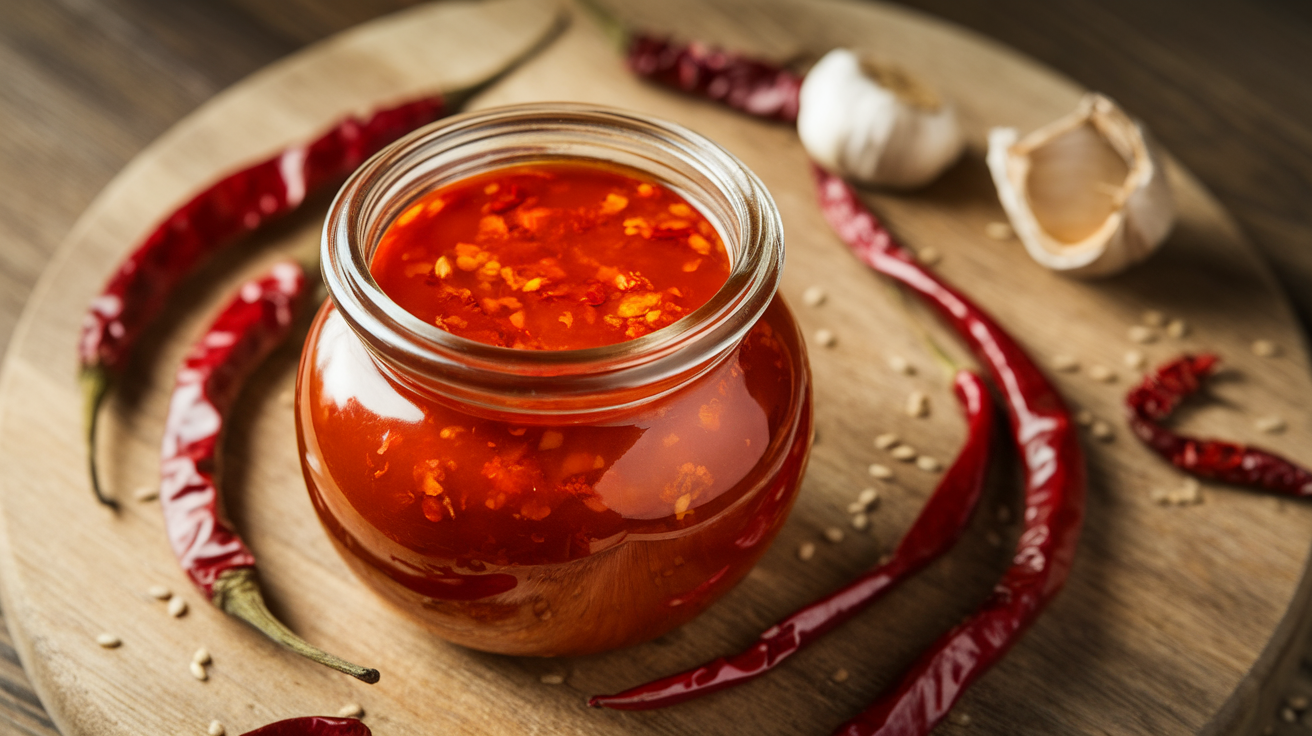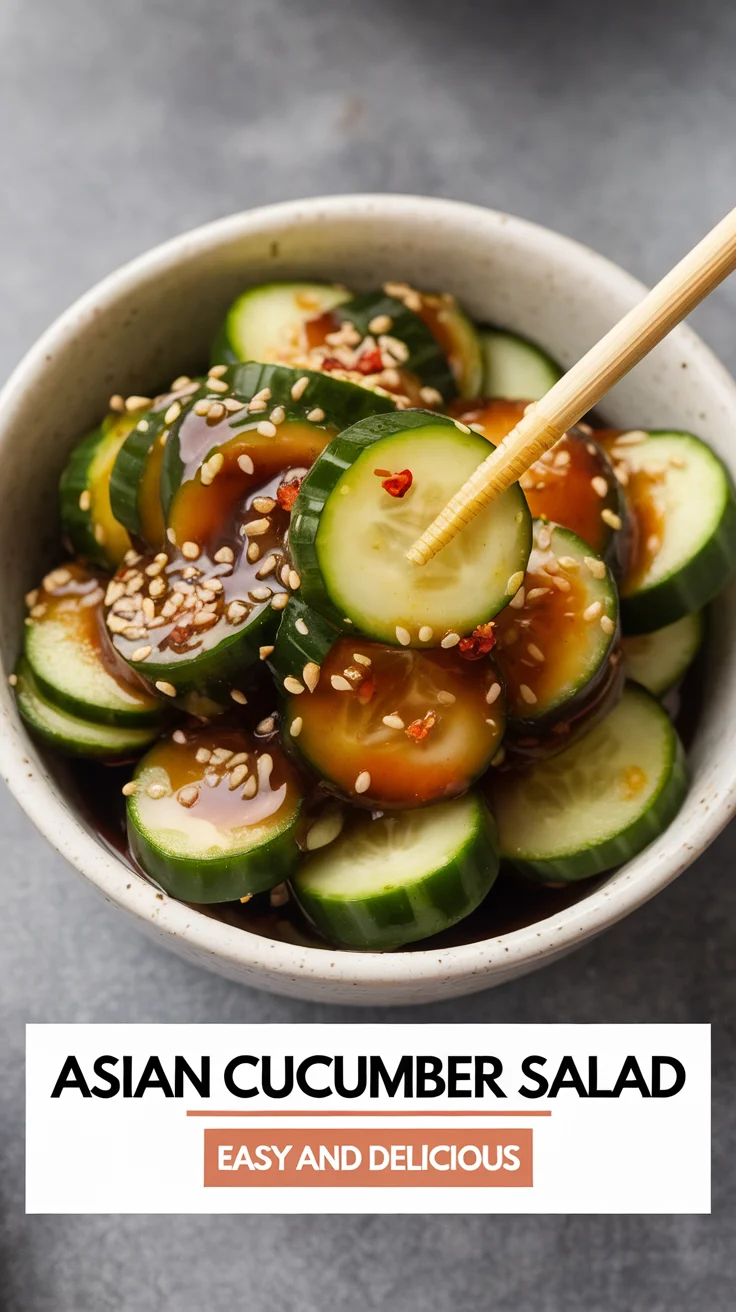Chili oil is a magical ingredient that has captured the hearts of spice lovers worldwide. It is more than just a condiment; it’s a flavorful experience that brings warmth, aroma, and an irresistible heat to dishes across cultures. Whether you are a seasoned cook or a curious beginner, mastering the art of chili oil opens up endless culinary possibilities.
In this comprehensive guide, you will find everything you need to know about making the best chili oil recipe at home, including authentic Korean chili oil recipe y Vietnamese chili oil recipe variations. We’ll explore how to use chili oil in everyday cooking, from simple snacks to elaborate meals, including a classic lapping recipe. We will also introduce the trendy chili crisp oil recipe, known for its crunchy texture and bold flavor.
Plus, discover useful tips from popular chili oil recipe videos, and learn how to make your own home made chili oil that suits your taste buds perfectly.
What Is Chili Oil? A Spicy History and Global Love Affair
At its core, chili oil is an infused oil where dried or fresh chili peppers are soaked in hot oil to extract their heat and flavor. It’s been used for centuries in various Asian cuisines, but the exact origins are a bit mysterious — some trace chili oil back to Sichuan province in China, while others point to Vietnam or Korea for their distinct takes.
Chili oil is revered for its ability to add depth and complexity to food beyond just heat. The oil carries the fruity, smoky, or floral notes of the chilies, mingling with aromatic spices and herbs used during preparation.
It is a cornerstone in dishes ranging from Chinese dumplings, Vietnamese pho, Korean bibimbap, to modern fusion recipes.
Why Make Your Own Chili Oil at Home?
While commercial chili oils are convenient, home made chili oil offers numerous benefits:
- Customizable Heat Level: You can control how spicy or mild you want it.
- Frescura: Homemade versions are free from preservatives and retain fresh flavors.
- Ingredient Control: Avoid additives, and experiment with different types of chilies and oils.
- Rentable: Making chili oil at home is inexpensive compared to premium bottled versions.
- Gift Idea: Homemade chili oil in a pretty jar makes a fantastic gift for foodies.
The Best Chili Oil Recipe: Simple, Authentic, and Delicious
Below is a reliable, easy best chili oil recipe that you can try immediately.
Ingredientes:
- 1 cup vegetable oil or peanut oil (neutral flavor oils preferred)
- 1/4 cup crushed dried red chili flakes (adjust for heat)
- 3 dientes de ajo, picados
- 1 small piece ginger, sliced thin
- 1 tsp Sichuan peppercorns (optional, for that signature numbing sensation)
- 1 tsp sugar
- 1 tbsp soy sauce (optional for added umami)
- Pizca de sal
Instrucciones:
- Heat the oil: In a small saucepan, gently heat oil on medium heat.
- Add aromatics: Add garlic, ginger, and Sichuan peppercorns. Fry carefully until fragrant but not browned (around 3-5 minutes).
- Prepare chili base: Place chili flakes and sugar in a heatproof bowl.
- Strain oil: Remove aromatics from oil with a slotted spoon or strain through a sieve.
- Combine: Slowly pour the hot oil over the chili flakes. The oil will bubble and sizzle as it infuses.
- Season: Stir in soy sauce and salt if using.
- Cool: Let the chili oil cool to room temperature, then transfer to a sterilized jar.
- Rest: For best flavor, let sit overnight before using.
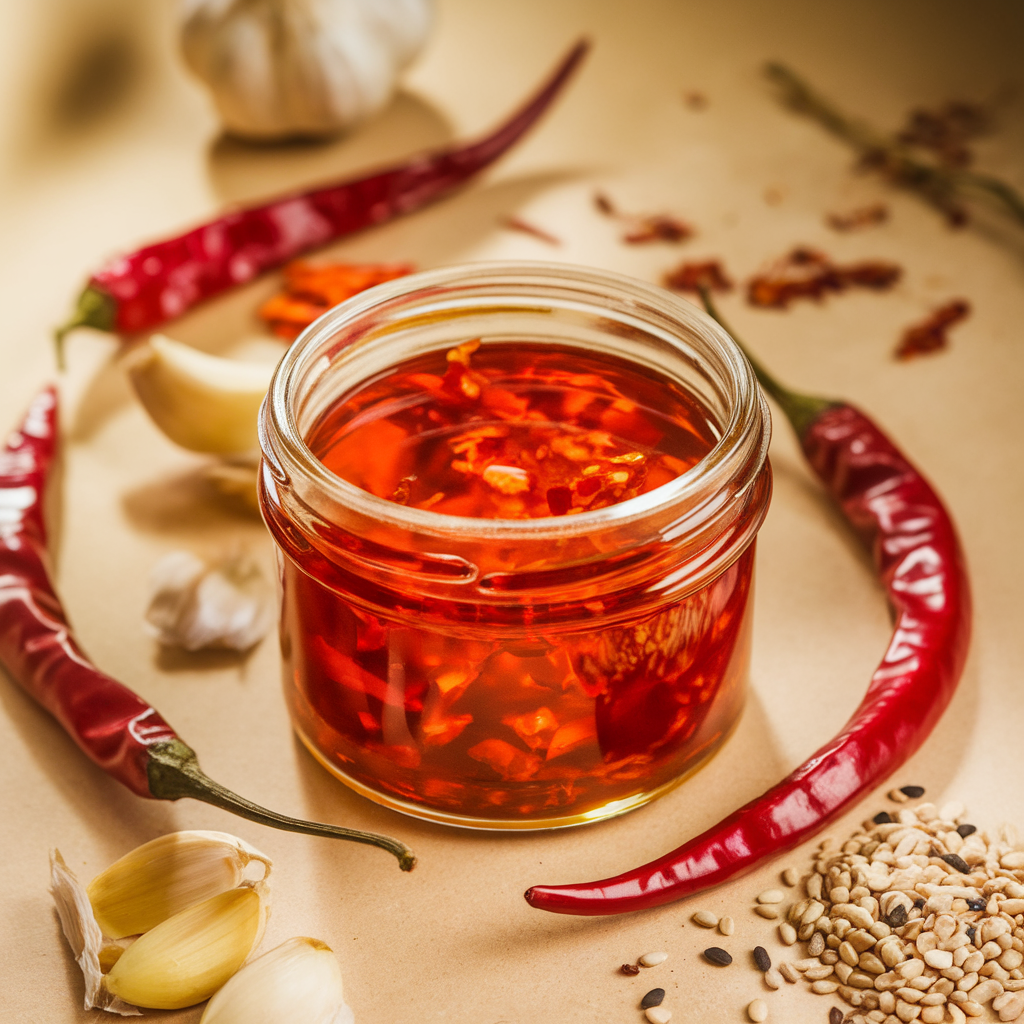
Korean Chili Oil Recipe: The Fiery Heart of Korean Cuisine
Korean cuisine’s unique use of chili oil stems from gochugaru, the signature Korean chili powder, which differs in flavor and heat from Chinese or Thai chilies. The Korean chili oil recipe often combines gochugaru with sesame oil and fermented elements like soy sauce or doenjang (fermented soybean paste) for complexity.
Ingredientes:
- 1 cup neutral oil (canola, grapeseed, or vegetable oil)
- 3 tbsp gochugaru (Korean red chili flakes)
- 2 tsp toasted sesame oil
- 2 dientes de ajo picados
- 1 tbsp soy sauce
- 1 tsp sugar
- Toasted sesame seeds for garnish
Preparation:
- Heat oil until shimmering but not smoking.
- Remove from heat and mix in gochugaru, garlic, and sugar.
- Stir well and add soy sauce and toasted sesame oil.
- Let the oil cool and settle.
- Sprinkle toasted sesame seeds on top before serving.
Uses:
- Drizzle over steamed rice bowls like bibimbap.
- Mix into noodles for spicy cold noodle salads.
- Use as a dipping sauce for dumplings and Korean fried chicken.
Vietnamese Chili Oil Recipe: Bright, Tangy, and Fresh
Vietnamese cuisine emphasizes fresh herbs and balanced flavors. The Vietnamese chili oil recipe often includes fish sauce, giving it a distinctive umami edge, and sometimes a splash of lime juice for acidity.
Ingredientes:
- 1 cup vegetable oil
- 1/4 cup crushed dried red chili flakes
- 4 cloves garlic, finely chopped
- 1 tbsp fish sauce
- 1 tsp sugar
- Juice of half a lime (optional)
Instrucciones:
- Heat oil and lightly fry garlic until golden.
- Remove garlic bits or leave some for texture.
- Mix chili flakes, fish sauce, and sugar into the hot oil.
- Add lime juice for freshness.
- Cool and store.
Ideal With:
- Pho broth for extra spice.
- Grilled meats and seafood.
- Stir-fried vegetables.
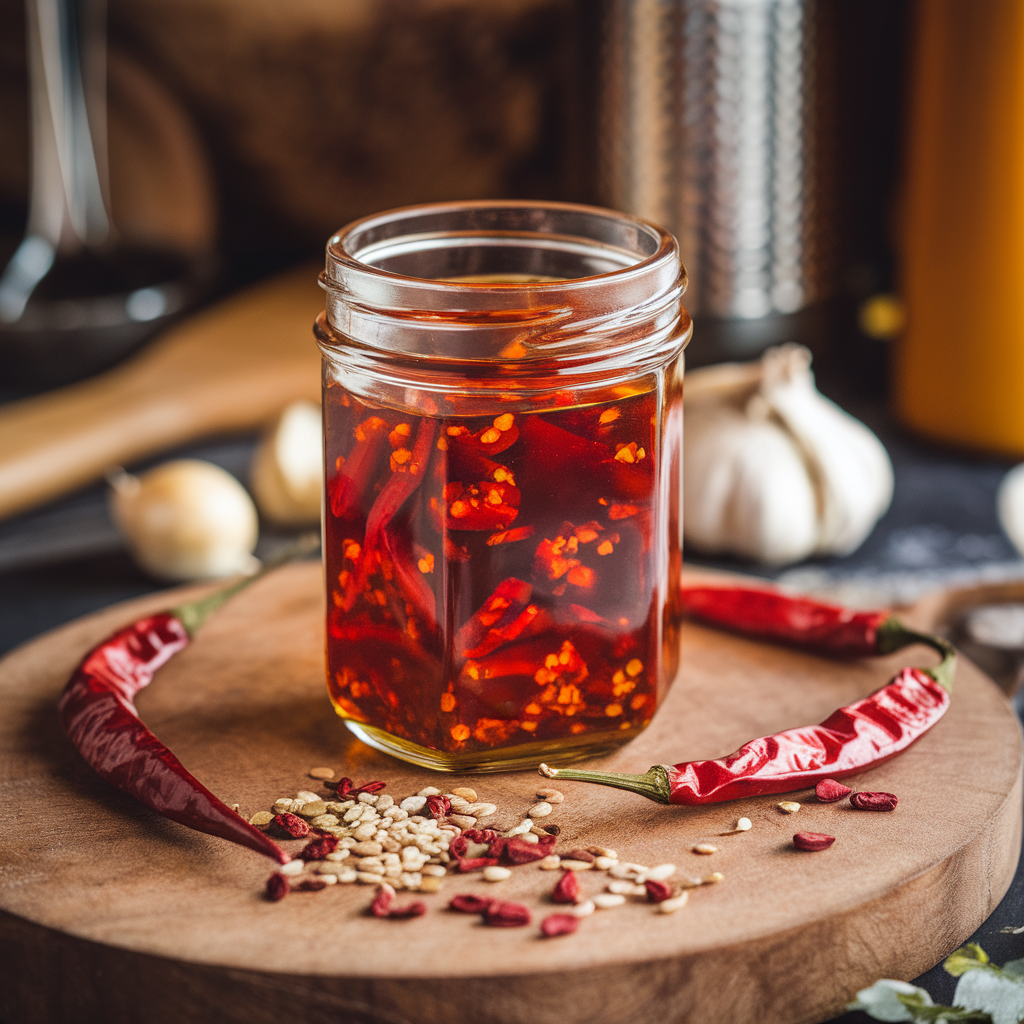
Chili Crisp Oil Recipe: Crunchy, Fiery, and Addictive
The chili crisp trend has taken the culinary world by storm, becoming a must-have pantry item. Unlike smooth chili oil, chili crisp oil recipe includes crispy fried garlic, shallots, peanuts, and sometimes dried shrimp for texture and umami.
Ingredientes:
- 1 cup neutral oil (vegetable or peanut)
- 3 tbsp chili flakes
- 3 garlic cloves, minced
- 2 shallots, thinly sliced
- 1 tsp sugar
- 1/4 cup roasted peanuts (optional)
- Sal al gusto
How to Make:
- Slowly fry garlic and shallots in oil until crisp and golden; remove half for topping.
- Add chili flakes, peanuts, sugar, and salt to the oil.
- Pour hot oil and crispy bits over chili flakes.
- Stir and cool before storing.
Delicious On:
- Steamed vegetables and rice.
- Noodles and dumplings.
- Eggs and avocado toast.
The Classic Lapping Recipe: Using Chili Oil in a Cold Noodle Salad
El lapping recipe is a famous spicy noodle dish from Yunnan province in China, well known for its refreshing yet fiery taste. It’s the perfect showcase for chili oil’s flavor.
Lapping Recipe Basics:
- Rice or mung bean noodles, cooked and cooled.
- Fresh cucumber, julienned.
- Cilantro, mint, and peanuts for freshness and crunch.
- Chili oil mixed with soy sauce, vinegar, sesame paste, and garlic to dress.
The chili oil here adds smokiness and heat, complementing the fresh herbs and tangy dressing perfectly.
How to Use Chili Oil in Everyday Cooking
The beauty of chili oil lies in its versatility. Here are some of the best ways to incorporate it into your meals:
1. Dipping Sauce
Mix chili oil with soy sauce, vinegar, or sesame oil to dip dumplings, spring rolls, or grilled meats.
2. Cooking Ingredient
Add chili oil to stir-fries, soups, and marinades to add depth and heat.
3. Topping and Drizzle
Drizzle chili oil over rice bowls, noodles, steamed vegetables, or even pizza and avocado toast.
4. Salad Dressing
Incorporate chili oil into dressings for spicy salads or cold noodle dishes like the lapping recipe.
5. Condiment for Eggs
Add a spoonful to scrambled eggs or fried eggs for a spicy upgrade.
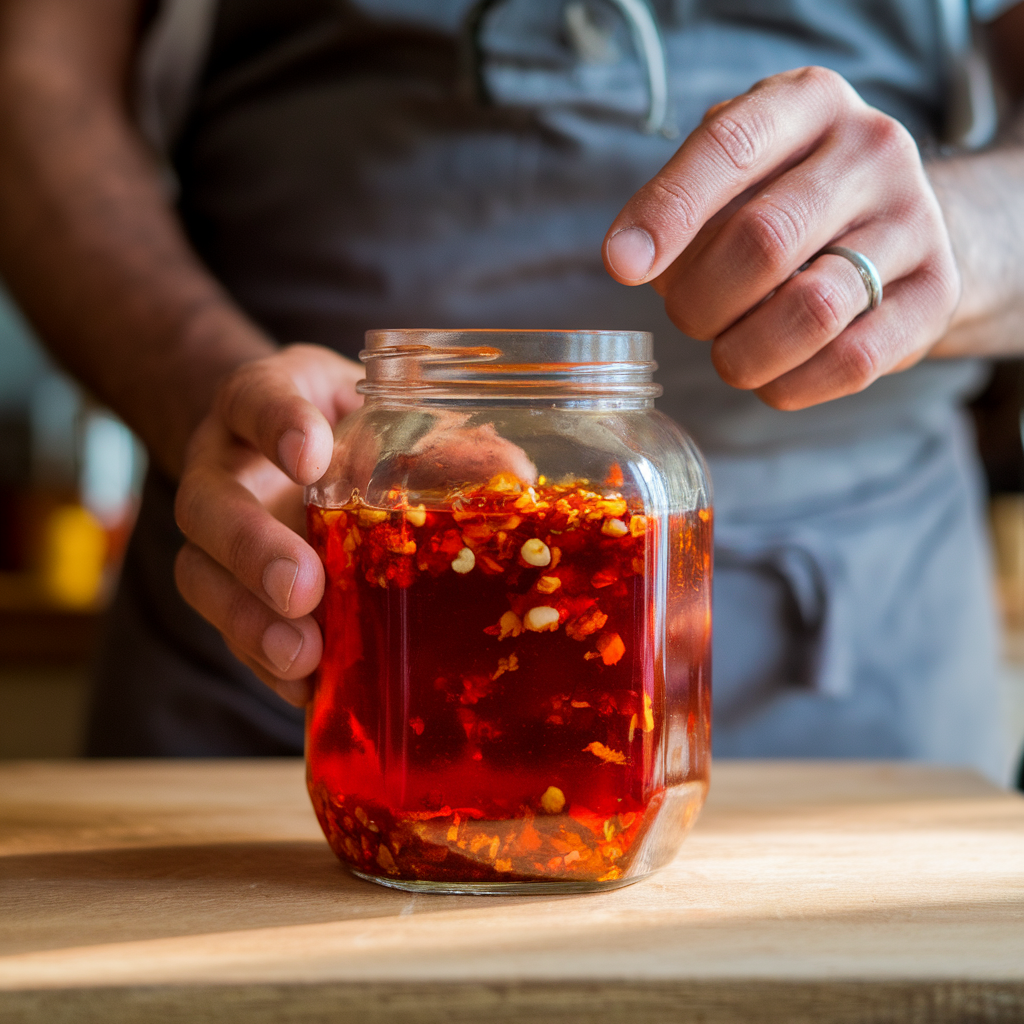
Chili Oil Recipe Videos: Visual Learning for Perfect Results
Sometimes watching a process is the best way to master it. Plenty of chili oil recipe videos are available on YouTube and social media platforms, guiding you through the steps visually.
These videos show how to:
- Get the perfect oil temperature to avoid burnt aromatics.
- Choose the best chili flakes or powders.
- Add crunchy bits for chili crisp.
- Create Korean and Vietnamese variations.
Following along with a video can give you the confidence to try making home made chili oil for yourself.
Tips for Making the Perfect Homemade Chili Oil
- Choose the right oil: Neutral oils like vegetable, canola, or peanut oil let the chili flavor shine. Use toasted sesame oil for finishing, not cooking.
- Control your heat: Use less or more chili flakes depending on your spice tolerance.
- Don’t burn garlic or spices: Burnt bits add bitterness; cook gently on medium-low heat.
- Infuse aromatics: Add star anise, cinnamon sticks, or bay leaves for extra layers.
- Let it rest: Chili oil develops flavor if rested for 24-48 hours.
Storage and Shelf Life of Chili Oil
Store chili oil in a clean, airtight jar in a cool, dark place or refrigerate. It can last for up to 2 months. Always use a clean spoon to avoid contamination.
Reflexiones Finales
Chili oil is an essential, transformative ingredient in many cuisines worldwide. Whether you prefer the smoky Korean chili oil recipe, the fresh and tangy Vietnamese chili oil recipe, or the crunchy delight of chili crisp oil recipe, making your own home made chili oil is rewarding and fun.
Use it to enhance your favorite meals—from the spicy lapping recipe noodles to simple rice and vegetable dishes. Watch chili oil recipe videos for guidance, experiment with flavors, and soon you’ll have your own signature chili oil to spice up your kitchen creations.
So grab your ingredients, get cooking, and bring the fiery magic of chili oil into your home! 🌶️🔥🍜
